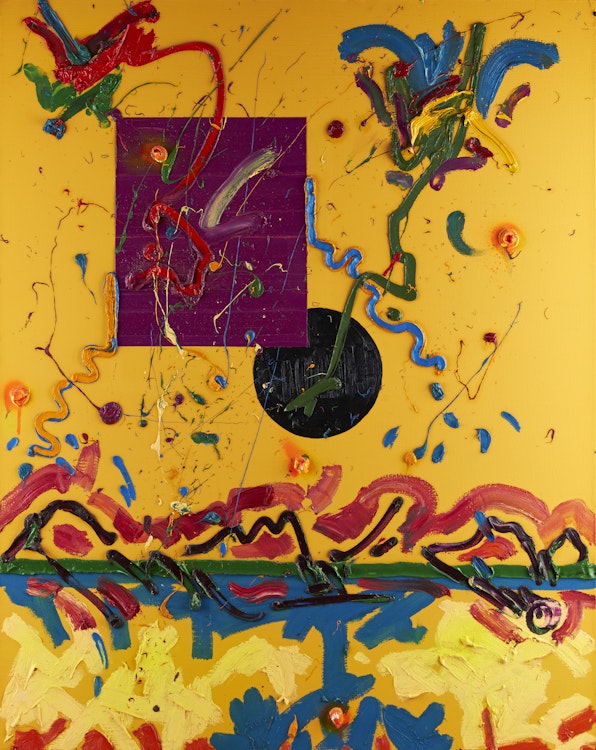Glitzy Illusion by Alex Cameron

Alex Cameron
Glitzy Illusion
oil on canvas
signed, titled and dated 2003 on the reverse
38 x 30 ins ( 96.5 x 76.2 cms )
Sale closed. Please contact us for details.
Provenance:
Private Collection, Toronto.
Private Collection, Toronto.
Literature:
Roald Nasgaard, “Abstract Painting in Canada”, Vancouver/Toronto, 2007, page 257.
Roald Nasgaard, “Abstract Painting in Canada”, Vancouver/Toronto, 2007, page 257.
Roald Nasgaard describes that Alex Cameron “...has an impeccable pedigree for a third generation modernist abstract painter in Toronto. He studied at the New School of Art under Coughtry, Rayner, Burton and Markle. He was Jack Bush’s studio assistant, worked for the David Mirvish Gallery and maintained an ongoing close relationship with Clement Greenberg. He showed with Jared Sable until he joined Klonaridis in 1985.”
The owner of “Glitzy Illusion”, a term which Cameron relates to the world of horse racing, with other paintings in the same series sharing similar titles, discussed and had confirmed their interpretation and description of the artwork with the painter:
“Stylistically, ‘Glitzy Illusion’ is in the colour field school of painting. Cameron built the abstraction from shapes derived from the landscape and ‘celestialscape.’ The artist first applied a brilliant yellow ochre base across the entire canvas. Along the lower portion of the surface, he then drew a thick green horizon line, below which he populated the area with a scattering of brush strokes in yellows, blues and ochre, depicting varied land and vegetation. Above the line, the viewer detects outlines of mountains in black and brown. The remainder of the upper part of the canvas is dominated by cosmic planetary objects, consisting of a disc, a square, comet-like shapes, and colourful flashing ‘buttons’ (stars), with thickly-crusted pigment floating against a deeply-coloured and intense orange background. The celestialscape is accompanied by dashes of colour and ropey deposits of pure pigment, squeezed directly from the tube, the worm-like lengths of paint adding vibration and agitation to the imagery. In addition, the composition is galvanized by a number of infinitely small threads and ‘hot wires’ of pigment and hue. Within ‘Glitzy Illusion,’ Cameron displays his love of the Canadian wilderness and his command of vivid and electric colours. The painting’s vibrant colouring and mercurial dashes and lines brilliantly demonstrate the rugged Canadian wilderness and the heavens above. Incidentally, Cameron’s use of Day-Glo colours gives ‘Glitzy Illusion’ a completely different identity when viewed under ultraviolet light.”
The owner of “Glitzy Illusion”, a term which Cameron relates to the world of horse racing, with other paintings in the same series sharing similar titles, discussed and had confirmed their interpretation and description of the artwork with the painter:
“Stylistically, ‘Glitzy Illusion’ is in the colour field school of painting. Cameron built the abstraction from shapes derived from the landscape and ‘celestialscape.’ The artist first applied a brilliant yellow ochre base across the entire canvas. Along the lower portion of the surface, he then drew a thick green horizon line, below which he populated the area with a scattering of brush strokes in yellows, blues and ochre, depicting varied land and vegetation. Above the line, the viewer detects outlines of mountains in black and brown. The remainder of the upper part of the canvas is dominated by cosmic planetary objects, consisting of a disc, a square, comet-like shapes, and colourful flashing ‘buttons’ (stars), with thickly-crusted pigment floating against a deeply-coloured and intense orange background. The celestialscape is accompanied by dashes of colour and ropey deposits of pure pigment, squeezed directly from the tube, the worm-like lengths of paint adding vibration and agitation to the imagery. In addition, the composition is galvanized by a number of infinitely small threads and ‘hot wires’ of pigment and hue. Within ‘Glitzy Illusion,’ Cameron displays his love of the Canadian wilderness and his command of vivid and electric colours. The painting’s vibrant colouring and mercurial dashes and lines brilliantly demonstrate the rugged Canadian wilderness and the heavens above. Incidentally, Cameron’s use of Day-Glo colours gives ‘Glitzy Illusion’ a completely different identity when viewed under ultraviolet light.”
Share this item with your friends

